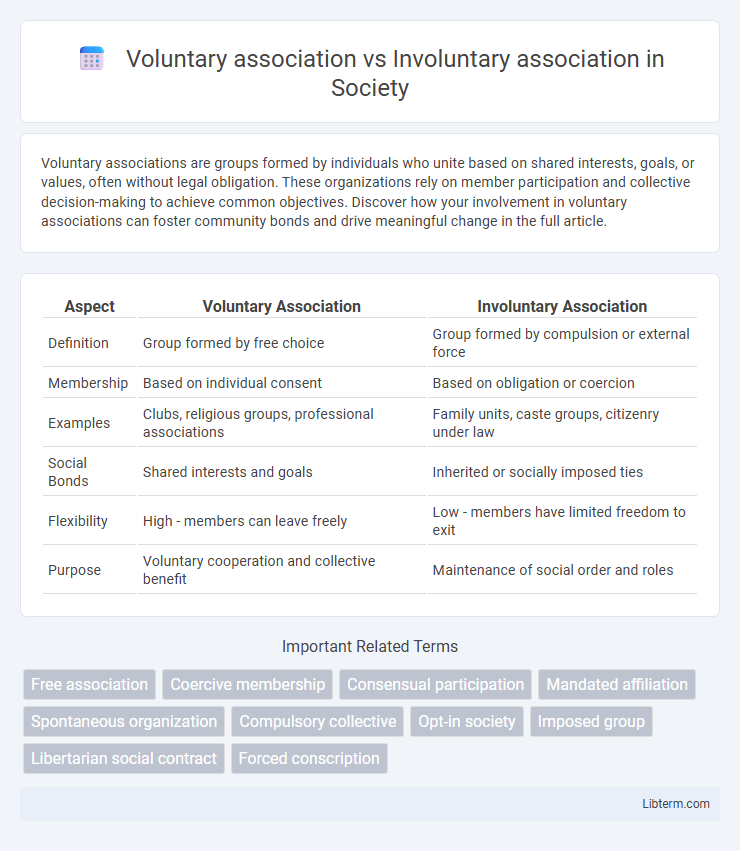Voluntary associations are groups formed by individuals who unite based on shared interests, goals, or values, often without legal obligation. These organizations rely on member participation and collective decision-making to achieve common objectives. Discover how your involvement in voluntary associations can foster community bonds and drive meaningful change in the full article.
Table of Comparison
| Aspect | Voluntary Association | Involuntary Association |
|---|---|---|
| Definition | Group formed by free choice | Group formed by compulsion or external force |
| Membership | Based on individual consent | Based on obligation or coercion |
| Examples | Clubs, religious groups, professional associations | Family units, caste groups, citizenry under law |
| Social Bonds | Shared interests and goals | Inherited or socially imposed ties |
| Flexibility | High - members can leave freely | Low - members have limited freedom to exit |
| Purpose | Voluntary cooperation and collective benefit | Maintenance of social order and roles |
Understanding Voluntary and Involuntary Associations
Voluntary associations consist of individuals who intentionally join based on shared interests, goals, or values, fostering cooperation and mutual benefit. Involuntary associations occur without personal choice, often based on inherent characteristics such as family ties, ethnicity, or legal obligations, influencing social dynamics and obligations. Understanding these distinctions clarifies how social networks form and the varying degrees of commitment and agency involved.
Defining Key Characteristics
Voluntary association refers to a group formed by individuals who freely choose to join based on shared interests, goals, or values, emphasizing consent and mutual benefit. Involuntary association occurs when individuals are grouped without choice, often due to external factors like legal mandates or social structures, highlighting obligation and lack of personal consent. Key characteristics distinguishing these associations include the element of choice, purpose of formation, and the nature of participation--voluntary associations prioritize intentional collaboration, whereas involuntary associations involve compulsory membership.
Historical Development of Associations
Historical development of voluntary associations traces back to ancient guilds and medieval craft unions formed by individuals seeking mutual benefits, highlighting self-determined collective action. Involuntary associations often emerged through state imposition or legal mandates, such as compulsory labor unions or conscription groups, reflecting structured societal control. Over time, the distinction shaped modern civil society, with voluntary associations emphasizing autonomy and participation, while involuntary groups represented institutional authority and social order.
Legal and Social Frameworks
Voluntary associations operate within legal frameworks that emphasize individual consent, enabling members to join or leave freely while enjoying collective rights and protections under association laws. Involuntary associations, often governed by statutory or regulatory mandates, impose membership without explicit consent, impacting legal accountability and individual autonomy. Social frameworks for voluntary associations typically promote trust, cooperation, and shared interests, whereas involuntary associations frequently involve hierarchical control and enforced compliance, influencing social dynamics and individual freedoms.
Examples of Voluntary Associations
Voluntary associations include organizations like professional societies, sports clubs, and nonprofit groups where members join by choice to pursue shared interests or goals. Examples are the American Red Cross, Rotary International, and local book clubs, all formed through the deliberate commitment of individuals seeking collective benefits. These groups contrast with involuntary associations, which are formed by external factors such as government-mandated entities like juries or conscription-based military units.
Examples of Involuntary Associations
Involuntary associations include family relationships, where individuals are connected by birth or legal ties, and governmental jurisdictions that impose legal obligations regardless of consent. Other examples involve caste systems or ethnic groups, where membership is assigned based on ancestry rather than personal choice. These associations contrast with voluntary groups such as clubs or professional organizations, which require explicit participation and agreement.
Benefits of Voluntary Membership
Voluntary associations offer members the freedom to choose participation based on shared interests and values, leading to higher engagement and satisfaction. Benefits of voluntary membership include stronger social bonds, greater personal investment, and enhanced opportunities for skill development and networking. These associations also promote a sense of community and collective goal achievement, which is often absent in involuntary groups.
Challenges in Involuntary Associations
Involuntary associations face significant challenges such as lack of member commitment, resistance to collaboration, and conflicts arising from forced participation. These issues often lead to low morale, reduced productivity, and difficulty achieving common goals. Unlike voluntary associations where members are motivated by shared interests, involuntary groups struggle to foster trust and effective communication.
Impact on Individual Freedoms
Voluntary associations enhance individual freedoms by allowing people to freely choose their memberships and participate based on shared interests or goals, fostering personal autonomy and self-expression. In contrast, involuntary associations, often imposed by external authorities or social pressures, can restrict personal freedom by limiting choice and enforcing conformity. The impact on individual freedoms is significant as voluntary memberships empower individuals, whereas involuntary associations may constrain their ability to act according to personal preferences.
The Future of Social Associations
The future of social associations hinges on evolving dynamics between voluntary and involuntary groups, with technology enabling more personalized and interest-driven voluntary associations. Involuntary associations, often rooted in geographic or institutional bonds, face challenges as digital connectivity redefines community boundaries and social interaction norms. Emerging data suggest a growing preference for voluntary associations that foster autonomy and shared values, signaling a shift toward more flexible and user-centric social structures.
Voluntary association Infographic

 libterm.com
libterm.com